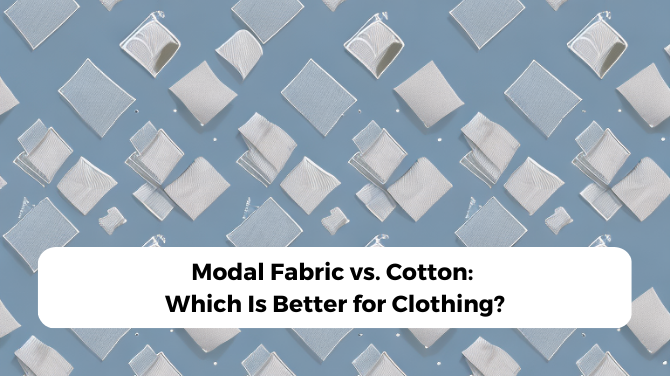When it comes to Modal fabric, there are a lot of misconceptions and confusion among people.
I could see a lot of questions about this topic on the internet.
That is why I have decided to compile a list of the most common question related to modal fabrics. Let’s begin.
What is Modal fabric and how it is made?
The modal fabric was originally developed in Japan in the 1950s.
It is a semi-synthetic fabric made from beech tree pulp that is used primarily for clothing.
Today, most modal is produced by the Austrian company Lenzing AG, which has the trademark for the fabric.
It is also produced in the names of Lenzing Modal, China Modal, Formatex, MicroModal, and Modal Air.
Modal is a type of rayon.
The production process is similar to that of rayon.
Beech cellulose is the raw material for making this fabric.
It is a chemical process where beech cellulose is soaked in sodium hydroxide and carbon disulfate.
This is why modal is considered a semi-synthetic fabric.
Modal Production simplified
- Beech tree cellulose is extracted from the pulp.
- Cellulose made into sheets and soaked in sodium hydroxide.
- Sheets are further broken and soaked in carbon disulfate to produce cellulose xanthate.
- Cellulose xanthate is soaked in hydroxide again.
- The subsequent liquid solution is put through a spinneret to create fibers.
- The fibers are soaked in sulphuric acid to form yarn.
- Yarn are washed and dried, then loaded onto spools.
- Yarns are then woven or knit into a fabric to form a modal.
Is modal fabric eco-friendly?
Modal can be an eco-friendly fabric if it is developed in a sustainable method. Previously we have seen that Modal is made using wood cellulose.
This may lead to deforestation.
We have to ensure that the sourcing of wood cellulose is from sustainably grown trees and not vice versa.
We have also seen that materials are soaked in harmful chemicals in various stages of modal production.
When we compare this with rayon, it actually uses fewer chemicals.
Modern modal production is done under a closed system where chemicals are not allowed to flow outside the ecosystem to cause any harm to the environment.
The Environmental Benchmark for Fibers by Made-By’s ranked D for modal considering these issues. It is a widely respected benchmark.
Is modal fabric good for summer?
Modal has a higher absorption rate when compared to cotton and it is also a breathable fabric.
These are the major properties required for an ideal summer cloth making Modal the right pick.
Besides, it looks luxurious with a soft and shiny look.
What are the pros of using Modal fabric?
Using modal fabrics made from sustainably harvested beech trees are good for nature.
It uses 20 times less water when compared to cotton.
Modal also eliminated the use of fabric softener or whitening agents.
It also requires a shorter washing cycle while doing laundry.
Which is better cotton or modal?
Cotton is more vulnerable than modal when it comes to shrinkage.
This is one of the reasons why modal and cotton are blended together.
They complement each other’s properties.
Modal is also more stretchy and durable than cotton.
If we compare these factors, we can say that modal is better than cotton.
Does modal fabric shrink?
Yes, modal shrinks at a reasonable rate.
It is advised to modal fabrics away from high temperature as it shrinks the fabrics even faster when compared with cotton, the shrinkage is less.
What are the properties of modal?
- It is 50% more absorbent than cotton.
- Modal fabric weave is more breathable making it ideal for sportswear.
- It has a luxurious texture.
- Blends easily with other fibers.
- Modal is soft, making it ideal also for sheets, pajamas, and undergarments.
- High dye absorption and does not bleed color while washing.
- Resists pilling.
- Highly strong fibers.
- Modal is completely biodegradable.
Does modal fabric need ironing?
Modal is mostly resistant to wrinkling. But there are cases when micro breakages happen in the fabric and it loses its quality.
So we can conclude that modal need occasional or low ironing compared to other fibers.
How to wash modal properly?
Modal is delicate clothing.
It is important to check instructions before washing. Some of the basic washing instructions are:
- Coldwater is ideal for the pure modal. Dry cleaning is not necessary.
- Dry in medium heat and away from direct sunlight.
- Avoid using chlorine-based bleaching. Instead, use an oxygen-based bleach.
What are the cons of using modal fabrics?
Modal is not a sustainable and eco-friendly fabric if no supervision over the manufacturing process since it involves trees and chemicals.
It is reported that more people are allergic to modal.
Itching, redness, and rashes are common experiences reported while using this material.
Modal fabric can easily tear if you run against fingernails, doorknob, or any other common household products.
Besides these cons, modal is a good material for making garments and other products.
*****
That’s it. I have tried to cover almost all the major questions revolving around modal fabric. If I have missed any, please mention them in the comment below.
Explore modal fabrics here.




